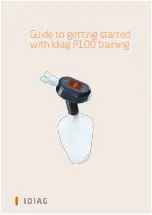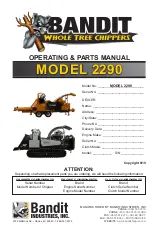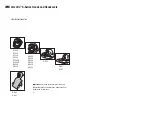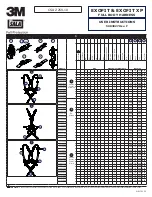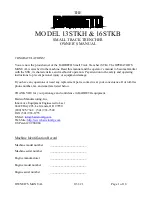
SECTION 2 - OPERATION
2-15
THEORY OF OPERATION
ROLL CONDITIONING
Roll conditioning passes the cut crop through a set of
closely spaced intermeshing rolls with matching lands
and valleys. The rolls crush and crack the plant stem
at several points along its length, which wears away
the waxy coating and allows moisture to escape.
There are two rolls in roll conditioning.
The lower roll is fixed in the machine.
The upper roll can pivot to let the crop mat feed
through the rolls without plugging.
Roll gap and roll tension affect crop conditioning.
See below for more information.
TC41
19
Roll Gap
The roll gap is the space between the land of one roll
and valley of the opposite conditioning roll. This
space should be kept between 0.4 mm – 3 mm (1/64
in. – 1/8 in.) to provide the best performance.
To check the roll gap easily and quickly in the field,
use the “one stem method”. Take one stem of the
crop being cut and pass it between the rolls at three
or four points across the roll width. The stem should
move between the rolls, but with some resistance. If
the stem passes through the gap with little or no
resistance, the gap should be reset closer (see
Section 2 -- Operation). If you cannot pass the stem
between the rolls at all, the gap should be increased
slightly. To get peak machine performance and
efficiency, check the roll gap before each cutting
during the season, and also when cutting different
forage crops because each crop will be different.
In high volume crops like Sudan grass and other
cane-type crops, increase the roll gap slightly to get
better crop flow through the rolls without sacrificing
good crop conditioning. The lands and valleys should
be centered to maintain a uniform distance on all
sides of the lands.
Roll Tension
After setting the roll gap, adjust the roll tension. Roll
tension is the amount of pressure added to restrict
upper roll movement as the crop feeds through the
rolls. Hard-to-condition crops require more tension.
Light and easily-conditioned crops require less
tension. Higher roll tensions increase the pressure
exerted on the crop mat as it moves between the
lands and valleys, increasing the ability of the rolls to
crack and wear the stem away. Higher roll tensions
result in more aggressive crop conditioning because
the rolls become more resistant to spreading apart as
the crop is fed through.
11-8-12
0.4 mm to 3 mm
(1/64
″
to 1/8
″
)
20
Содержание Haybine 499
Страница 1: ... 5HSODFHV OO 3UHYLRXV VVXHV ...
Страница 2: ... 1 PHULFD ...
Страница 28: ...SECTION 1 GENERAL INFORMATION 1 18 ...
Страница 50: ...SECTION 2 OPERATION 2 22 ...
Страница 60: ...SECTION 3 LUBRICATION 3 10 ...
Страница 71: ...SECTION 4 MAINTENANCE 4 11 9 Tighten bolts 1 and nuts 2 10004725 1 1 2 12 ...
Страница 110: ...SECTION 4 MAINTENANCE 4 50 ...
Страница 114: ...SECTION 5 TROUBLESHOOTING 5 4 ...
Страница 122: ...SECTION 7 SPECIFICATIONS 7 4 ...
Страница 126: ...7 8 ...
Страница 128: ...7 10 ...

































